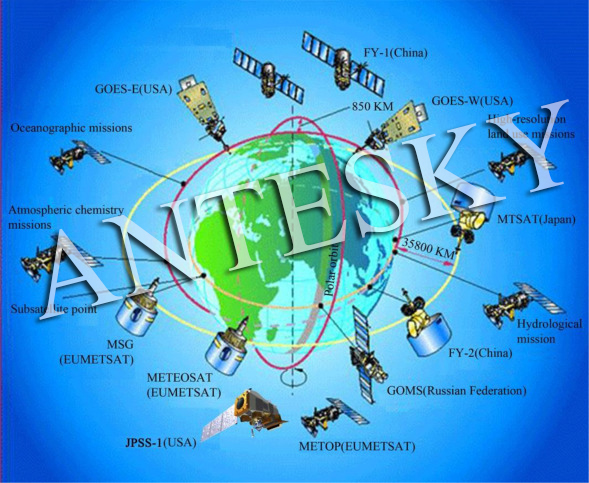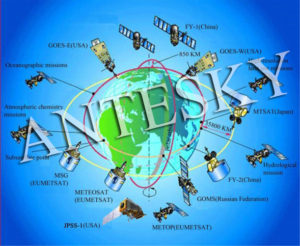
L-band for Weather Satellite Data Receiving System is the operating frequency with the range of 1–2 GHz in the radio spectrum. The wavelength range is 30–15 cm. L band with a low bandwidth due to its low frequency is one of the chief operating ranges used by many applications such as radars, radio, global positioning systems (GPS), telecommunications and aircraft surveillance. The equipment needed is less sophisticated less expensive.
Some of the general applications include – Low earth orbit satellites, military satellites and mobile communications. It is also used by GPS/GNSS technologies – L1 Band: 1575.42 MHz, L2: 1227.60 MHz, L3 Band: 1381.05 MHz, L5 Band: 1176.45 MHz. The International Telecommunication Union has allowed the 1240 to 1300 MHz band to be used for amateur radio operations. In addition to this the 1260 MHz to 12 70 MHz band are used for amateur satellite up-links.
L band is used in many radar, satellite and terrestrial communications applications. L band has a low bandwidth due to its low frequency range and hence is not suitable for streaming applications like video, voice and broadband connectivity. However, it is the most desirable operating range in the case of applications like fleet management and asset tracking.
L band is the cheapest and easiest to manage when compared to other higher frequency ranges like C band and S band. It is easier to obtain only low-cost RF equipment. It has a wider beam width and hence does not require a high-quality antenna with accurate directionality that is needed by higher bands.
L band radars are used for clear air turbulence studies and by low-Earth orbit satellites to provide real-time visibility to monitoring the status of equipment from a remote location and to provide machine to machine (M2M) communications. They are also used in terrestrial wireless connections like GSM mobile phones and in GPS satellites. They may also be used as an intermediate frequency for satellite TV to allow easier transmission.
The use of L-band technology can reduce overhead and is not affected by high frequency signal loss when transmitted over copper coaxial cables. It is not easily affected by interruptions and provides reliable connectivity. These beneficial features make the L-band an appropriate technology for remote monitoring and operational management.
All GPS signals are in the L-band (1-2 GHz) of the spectrum. Because L-band waves penetrate clouds, fog, rain, storms and vegetation, GPS devices can receive accurate data in all weather conditions during the day or night. In some cases, GPS devices may not be able to receive signals accurately, such as inside concrete buildings or heavy forest canopies.
The choice of GPS carrier frequency (transmission data signal) meets the following requirements:
- The frequency should be less than 2 GHz, as the frequency above 2 GHz requires a beam antenna to receive the signal.
- Ionospheric latency is very large for frequencies below 1,000 MHz and higher than the frequency range of three GHz. The PRN code (described in the glossary) requires high bandwidth for code modulation on the carrier frequency.
Therefore, a series of high frequencies with high bandwidth possibilities must be selected.
- The selected frequency should be within the range of signal propagation that is not affected by weather phenomena such as rain, snow or clouds.
For these reasons, the choice of L-band frequency proved to be advantageous. Each GPS satellite (block IIF and above) sends three carrier signals in the microwave range of the electromagnetic spectrum, called L1,L2 and L5 (the frequency is located in the L band between the spectrum 1,000 and the 2,000MHz). The L1 frequency is 1,575.42MHz (wavelength 19.05cm), the L2 frequency is 1,227.60MHz (wavelength 24.45cm), and the L5 frequency is 1,176.45MHz (wavelength 25.48cm).
L-band for Weather Satellite Data Receiving System are artificial earth satellites that perform meteorological observations of the Earth and its atmosphere from space. The satellite carries a variety of meteorological remote sensors that receive and measure visible, infrared and microwave radiation from the Earth and its atmosphere and convert it into electrical signals for transmission to ground stations which restores the electrical signals from the satellites and maps them into various clouds, surface and sea pictures, and then further processes and calculates them to obtain various meteorological data. Meteorological satellites have a wide range of observations and are not subject to natural conditions and geographical conditions. The meteorological information provided by it has been widely used in daily meteorological services, environmental monitoring, disaster prevention and mitigation, and the atmosphere. Research in science, oceanography and hydrology. Meteorological satellites are also one of the most widely used satellites in the world.
According to different operational orbits, meteorological satellites are classified into geostationary satellites and polar-orbiting satellites.
A polar orbit meteorological satellite, also known as a sun-synchronous orbiting meteorological satellite, is orbiting the sun through the Earth’s north and south poles. Meteorological satellites generally operate in polar or geosynchronous orbits, while polar orbiting meteorological satellites generally have an orbital altitude of 650 to 1500 km. They can provide accurate information on medium-term numerical weather prediction, climate diagnosis and prediction, natural disasters and environmental monitoring. Observation data. Polar orbiting meteorological satellites can provide global meteorological parameters such as temperature, humidity, cloud and radiation for weather forecasting, especially numerical weather forecasting, monitor large-scale natural disasters, study global ecological and environmental changes, explore climate change laws, and diagnose climates. And predictions provide the required geophysical parameters.
The geostationary meteorological satellite is a type of geosynchronous orbit satellite that is used in geosynchronous orbits and is located in geosynchronous orbit. The track is located above the equator and has a height of 36,000 kilometers. It runs synchronously with the Earth’s rotation and has a 24-hour operation period. Relative to the Earth’s stillness, it is possible to observe a fixed area of 1/3 of the Earth’s surface. The main advantage of geostationary meteorological satellites is the high frequency of observations, which can capture weather phenomena with relatively fast changes, mainly used for weather analysis, especially for mesoscale and strong convective weather warnings and forecasts.
The Antesky meteorological satellite data receiving system applies this 7.3-meter meteorological satellite receiving system.
It is a complete, ready-to-use system that provides all the hardware and software for receiving and transmitting data and processing it into image files.
L band is used in many radar, satellite and terrestrial communications applications. L band has a low bandwidth due to its low frequency range and hence is not suitable for streaming applications like video, voice and broadband connectivity. However, it is the most desirable operating range in the case of applications like fleet management and asset tracking.
Using L-band technology reduces overhead and does not suffer from high signal loss experienced by high frequencies when transported over copper coax cables. It is less susceptible to interruptions and provides a reliable connection. These beneficial properties make L band a suitable technology for use in remote monitoring and operations management.
Further reading about Antesky L- band Receiving only antenna
Customer Testimonial Of 2.4m L-Band Rx. Only Antenna







